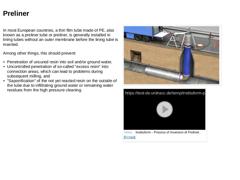
|
In most European countries, a thin film tube made of PE, also known as a preliner tube or preliner, is generally installed in lining tubes without an outer membrane before the lining tube is inserted. Among other things, this should prevent: -
Penetration of uncured resin into soil and/or ground water,
-
Uncontrolled penetration of so-called "excess resin" into connection areas, which can lead to problems during subsequent milling, and
-
"Saponification" …
|
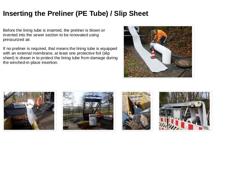
|
Before the lining tube is inserted, the preliner is blown or inverted into the sewer section to be renovated using pressurized air. If no preliner is required, that means the lining tube is equipped with an external membrane, at least one protective foil (slip sheet) is drawn in to protect the lining tube from damage during the winched-in-place insertion. (Image: Insertion of the preliner by means of pressurized air) (Image: Protective / sliding foil) (… |
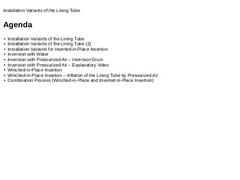
|
|
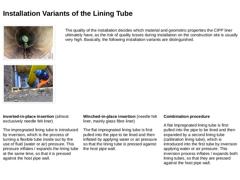
|
(Image: Inverted-in-place insertion of a lining tube) (Image: Winched-in-place insertion of a lining tube) The quality of the installation decides which material and geometric properties the CIPP liner ultimately have, as the risk of quality losses during installation on the construction site is usually very high. Basically, the following installation variants are distinguished. Inverted-in-place insertion (almost exclusively needle felt liner) The impregnated … |
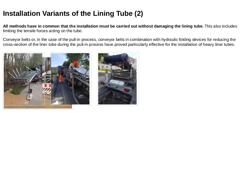
|
All methods have in common that the installation must be carried out without damaging the lining tube. This also includes limiting the tensile forces acting on the tube. Conveyor belts or, in the case of the pull-in process, conveyor belts in combination with hydraulic folding devices for reducing the cross-section of the liner tube during the pull-in process have proved particularly effective for the installation of heavy liner tubes. (Image: Installation … |
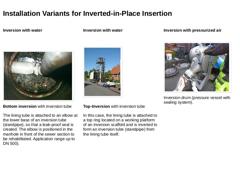
|
Inversion with water (Image: Bottom-Inversion – Lining tube, elbow, inversion tube) Bottom inversion with inversion tube The lining tube is attached to an elbow at the lower base of an inversion tube (standpipe), so that a leak-proof seal is created. The elbow is positioned in the manhole in front of the sewer section to be rehabilitated. Application range up to DN 500). Inversion with water (Image: Top-Inversion - Inversion scaffold with working platform … |
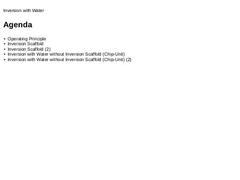
|
|
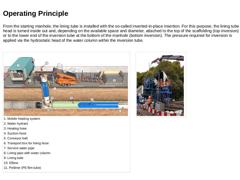
|
From the starting manhole, the lining tube is installed with the so-called inverted-in-place insertion. For this purpose, the lining tube head is turned inside out and, depending on the available space and diameter, attached to the top of the scaffolding (top inversion) or to the lower end of the inversion tube at the bottom of the manhole (bottom inversion). The pressure required for inversion is applied via the hydrostatic head of the water column … |
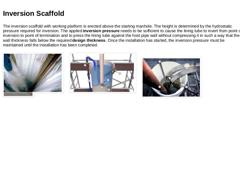
|
The inversion scaffold with working platform is erected above the starting manhole. The height is determined by the hydrostatic pressure required for inversion. The applied inversion pressure needs to be sufficient to cause the lining tube to invert from point of inversion to point of termination and to press the lining tube against the host pipe wall without compressing it in such a way that the wall thickness falls below the required design thickness |
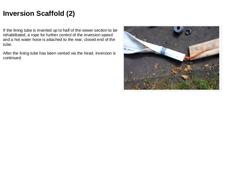
|
If the lining tube is inverted up to half of the sewer section to be rehabilitated, a rope for further control of the inversion speed and a hot water hose is attached to the rear, closed end of the tube. After the lining tube has been vented via the head, inversion is continued. (Image: For small diameters, the heating hose simultaneously serves as a control cable to control the speed of the inversion process) |
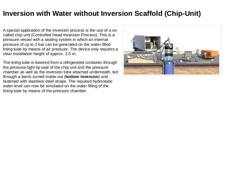
|
A special application of the inversion process is the use of a so-called chip unit (Controlled Head Inversion Process). This is a pressure vessel with a sealing system in which an internal pressure of up to 2 bar can be generated on the water-filled lining tube by means of air pressure. The device only requires a clear installation height of approx. 2.5 m. The lining tube is lowered from a refrigerated container through the pressure-tight lip seal … |
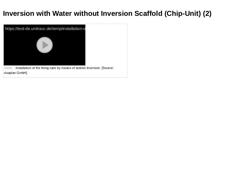
|
(Video: Installation of the lining tube by means of bottom inversion) |
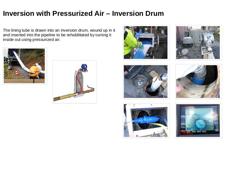
|
The lining tube is drawn into an inversion drum, wound up in it and inserted into the pipeline to be rehabilitated by turning it inside out using pressurized air. (Image: Schematic principle of inverted-in-place insertion with pressurized air) (Image: Inverted-in-place insertion with pressurized air - Inversion drum is positioned in the truck) (Image: Schematic principle of inserting the lining tube into the inversion drum) (Image: Inserting the lining … |
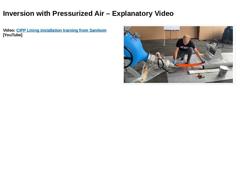
|
Video: CIPP Lining installation training from Sanikom [YouTube] (Image: Screenshot Video - CIPP lining installation training from Sanikom) |
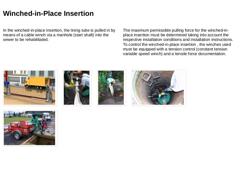
|
In the winched-in-place insertion, the lining tube is pulled in by means of a cable winch via a manhole (start shaft) into the sewer to be rehabilitated. The maximum permissible pulling force for the winched-in-place insertion must be determined taking into account the respective installation conditions and installation instructions. To control the winched-in-place insertion , the winches used must be equipped with a tension control (constant tension … |
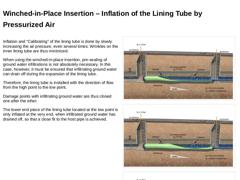
|
Inflation and “Calibrating" of the lining tube is done by slowly increasing the air pressure, even several times. Wrinkles on the inner lining tube are thus minimized. When using the winched-in-place insertion, pre-sealing of ground water infiltrations is not absolutely necessary. In this case, however, it must be ensured that infiltrating ground water can drain off during the expansion of the lining tube. Therefore, the lining tube is installed with … |
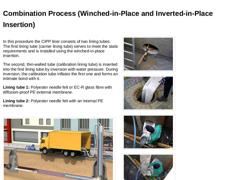
|
In this procedure the CIPP liner consists of two lining tubes. The first lining tube (carrier lining tube) serves to meet the static requirements and is installed using the winched-in-place insertion. The second, thin-walled tube (calibration lining tube) is inserted into the first lining tube by inversion with water pressure. During inversion, the calibration tube inflates the first one and forms an intimate bond with it. Lining tube 1: Polyester … |
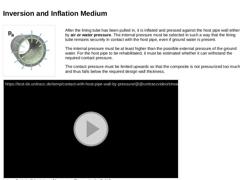
|
(Image: The internal pressure must be at least higher than any external groundwater pressure) After the lining tube has been pulled in, it is inflated and pressed against the host pipe wall either by air or water pressure. The internal pressure must be selected in such a way that the lining tube remains securely in contact with the host pipe, even if ground water is present. The internal pressure must be at least higher than the possible external pressure … |
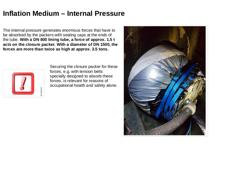
|
The internal pressure generates enormous forces that have to be absorbed by the packers with sealing caps at the ends of the tube. With a DN 800 lining tube, a force of approx. 1.5 t acts on the closure packer. With a diameter of DN 1500, the forces are more than twice as high at approx. 3.5 tons. Important: Securing the closure packer for these forces, e.g. with tension belts specially designed to absorb these forces, is relevant for reasons of occupational … |
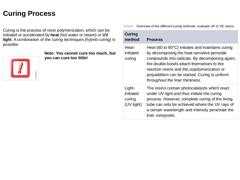
|
Curing is the process of resin polymerization, which can be initiated or accelerated by heat (hot water or steam) or UV light. A combination of the curing techniques (hybrid curing) is possible. Important: Note: You cannot cure too much, but you can cure too little! (Table: Overview of the different curing methods, example UP or VE resins) |
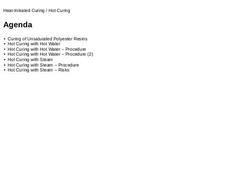
|
|
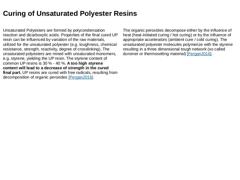
|
Unsaturated Polyesters are formed by polycondensation reaction and dicarboxylic acids. Properties of the final cured UP resin can be influenced by variation of the raw materials, utilized for the unsaturated polyester (e.g. toughness, chemical resistance, strength, reactivity, degree of crosslinking). The unsaturated polyesters are mixed with unsaturated monomers, e.g. styrene, yielding the UP resin. The styrene content of common UP resins is 30 % - … |
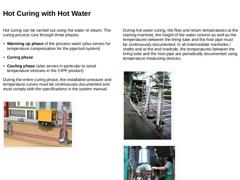
|
Hot curing can be carried out using hot water or steam. The curing process runs through three phases. During the entire curing phase, the installation pressure and temperature curves must be continuously documented and must comply with the … |
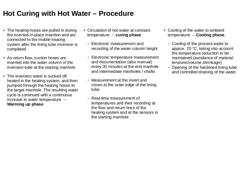
|
-
The heating hoses are pulled in during the inverted-in-place insertion and are connected to the mobile heating system after the lining tube inversion is completed
-
As return flow, suction hoses are inserted into the water column of the inversion tube at the starting manhole
-
The inversion water is sucked off, heated in the heating system, and then pumped through the heating hoses to the target manhole. The resulting water cycle is continued with …
|
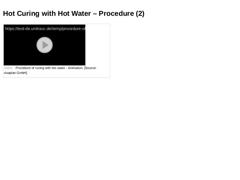
|
(Video: Procedure of curing with hot water - Animation) |